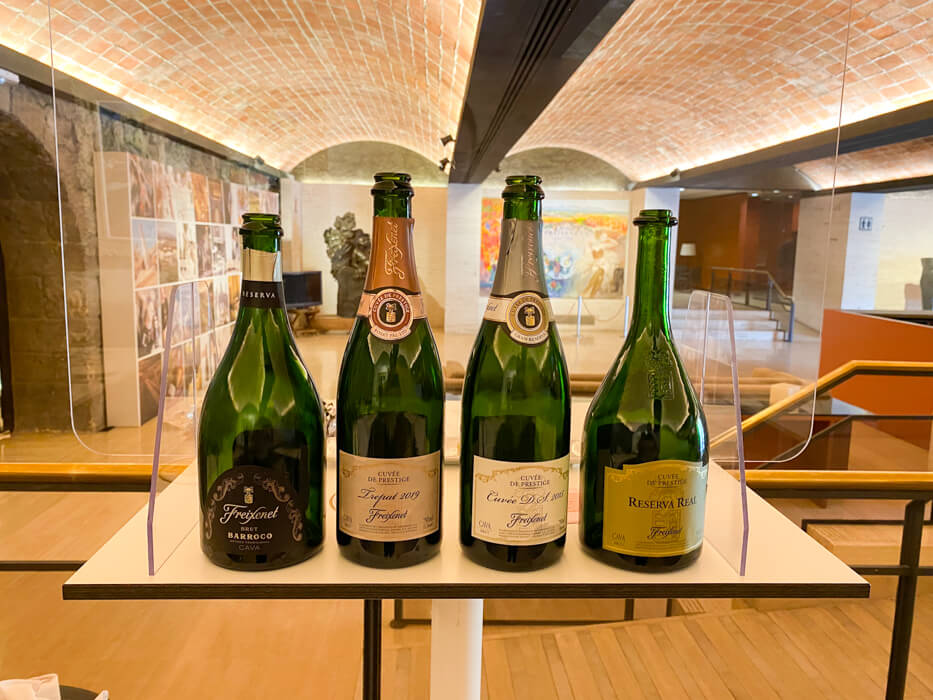45 minutes away from Barcelona, in the village of Sant Sadurní d’Anoia, the emblematic winery Feixenet is located. Not only the number one in the market of cavas (Spanish sparkling wine), in 2020 the winery distributed around 100 million bottles around the globe, despite the pandemic.
The legacy started (past simple) in 1911, after the union of two families, one a family of winegrowers and the other owners of the farm. Thereby, Dolores Sala Vivé and Pedro Ferrer Bosch (who had a nickname of Freixenet) got married and then, after a successful partnership, in 1914 the first bottle of Freixenet was released. The launch was successful, and it spread throughout the whole world in no time.
What is the cava?
Cava is a denomination of origin for Spanish sparkling wines, it is mainly produced in Catalonia. In fact, Sant Sadurní d’Anoia is the Catalan village where the majority of this wine comes from. The production process can be compared to French champagne.
However, the biggest difference is in the grapes they use. Traditionally, for producing cava this triad of grapes is used: Macabeo, Xarel.lo, Parellada.
Of course, life is not always a bed of roses and the Freixenet story that goes back for more than a century has some bitter scars. The company, in the beginning a family business, had dramatic moments, such as the Spanish Civil War, in 1936, that led to the collectivization of Freixenet (when they lost control of their company) and then the death of Pedro Ferrer and his eldest son, Joan Ferrer Sala. A tragic part of the story for both the family and the company.
Nevertheless, when the war was over and after a lot of effort, the family was able to take its company back. So, in 1941 the most emblematic label was launched, the Carta Nevada. It was a huge success, and it’s still the bestseller, even 80 years after its creation.
If after this quick overview of Freixenet’s story you are convinced that the visit is worth it, stay with me, and I’ll give you more practical details.
How to get there?
From Barcelona, by train it’s really easy:You have to take the train (Rodalies) going to Sant Vicenç de Calders (Line R4)
- You have to take the train (Rodalies) going to Sant Vicenç de Calders (Line R4)
- There are trains leaving every 30 minutes (aprox)
- The trip takes about 45 minutes
- The station is in Sant Sadurní d’Anoia and is located right in front of the winery.
If you have time, you can walk to the small centre, explore and have something to eat or drink. It will be 20 minutes walking.
⚠️ Important: Try to book your tour in advance on their website ⚠️
Visit, Tasting and Iberian hams
In the first place, the building itself is fascinating. In the courtyard, there is a small old car exposition that allows us to travel back in time. Then, the visit starts with a short film telling us a bit about its story.
Next, the groups are taken on a guided tour. It’s a nice walk through the story, where they tell us about the company, the innovation in advertising, and of course, about the whole production process of the Catalonian icon; cava.
We got, among the options of tours and tasting, the Tasting of Cavas and Iberian Hams. It was a great choice.
The tour takes about 2h30. An expert explains, very kindly, every inch of the winery. And I have to say, even though the building is huge, the tour goes through all the historical rooms, including the famous Salón Real.
The tour is over, now it’s time for tasting and Iberian hams. In our case, we had a pairing of four cavas with great Iberian hams:
The tour is over, now it’s time for tasting and Iberian hams. In our case, we had a pairing of four cavas with great Iberian hams:
- Barroco
- Trepat 2019
- Cuvée DS 2015
- Reserva Real
The tour guide explains, very patiently, details of each one of the labels and how each Iberian ham can affect the flavour of the cava.
And that is it! As expected, we left Freixenet carrying a few bottles, we also left with improved knowledge about cavas and an understanding that there are interesting places to visit beyond Barcelona.











